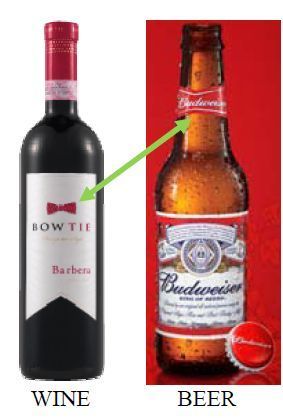 In what appears to be another instance of trademark overreaching, Anheuser-Busch (“AB”) is being sued for sending a tenuous trademark cease and desist letter to San Antonio Winery (“SAW”) accusing SAW’s Bow Tie word mark and Bow Tie slogan of infringing AB’s U.S.P.T.O. design mark registrations for a solid polygon, a striped polygon, and the term “Budweiser” in a polygon. SAW, a trademark infringement lawsuit veteran that previously sued Banfi for trademark and trade dress infringement, wants the court to rule that its use of the Bow Tie word mark and the Bow Tie Slogan (“Bow Tie – the best dressed wine in the class”) does not infringe the Budweiser Design Marks or constitute unfair competition.
In what appears to be another instance of trademark overreaching, Anheuser-Busch (“AB”) is being sued for sending a tenuous trademark cease and desist letter to San Antonio Winery (“SAW”) accusing SAW’s Bow Tie word mark and Bow Tie slogan of infringing AB’s U.S.P.T.O. design mark registrations for a solid polygon, a striped polygon, and the term “Budweiser” in a polygon. SAW, a trademark infringement lawsuit veteran that previously sued Banfi for trademark and trade dress infringement, wants the court to rule that its use of the Bow Tie word mark and the Bow Tie Slogan (“Bow Tie – the best dressed wine in the class”) does not infringe the Budweiser Design Marks or constitute unfair competition.
At the heart of every trademark dispute is prevention of consumer confusion and “the synonymous right of a trademark owner to control his product’s reputation.” James Burrough Ltd. v. Sign of the Beefeater, Inc., 540 F.2d 266, 274 (7th Cir. 1976). SAW “contends that its use of the BOW TIE word Mark will not cause consumers to be confused or deceived into believing that San Antonio’s BOW TIE wine comes from Anheuser-Busch or that San Antonio’s BOW TIE wine is affiliated with, connected with or sponsored or licensed by Anheuser-Busch.”
For potential consumers and readers that may be confused by the parties’ respective marks, I have taken the liberty to label SAW’s product as “WINE” and AB’s product as “BEER” to quell any befuddlement. Because the last time I ordered a beer at a game I was asked whether I wanted the beer with a bow tie and predicted the need for the labeling clarification. Seriously though, I was unaware that Budweiser’s label was even meant to represent a bowtie and I think the same can be said for a great number of consumers. And yes, I know that wine and beer are related in a likelihood of confusion analysis and finding, but the marks here – when compared in context – are so completely dissimilar when viewed under marketplace conditions that AB will not be able to establish that consumers are likely to be confused. Lindy Pen Co. v. Bic Pen Corp., 725 F.2d 1240, 1245-46 (9th Cir. 1984) (even where marks were identical when viewed in isolation, determination of likely confusion required consideration “in light of the way the marks are encountered in the marketplace and the circumstances surrounding the purchase of the pens,” which sufficed to distinguish the two marks except in context of telephone solicitation, where such distinctions were not evident).
The case is San Antonio Winery, Inc. v. Anheuser-Busch, LLC, CV12-7067 MMM (C.D. Cal. 2012).
 Los Angeles Intellectual Property Trademark Attorney Blog
Los Angeles Intellectual Property Trademark Attorney Blog

